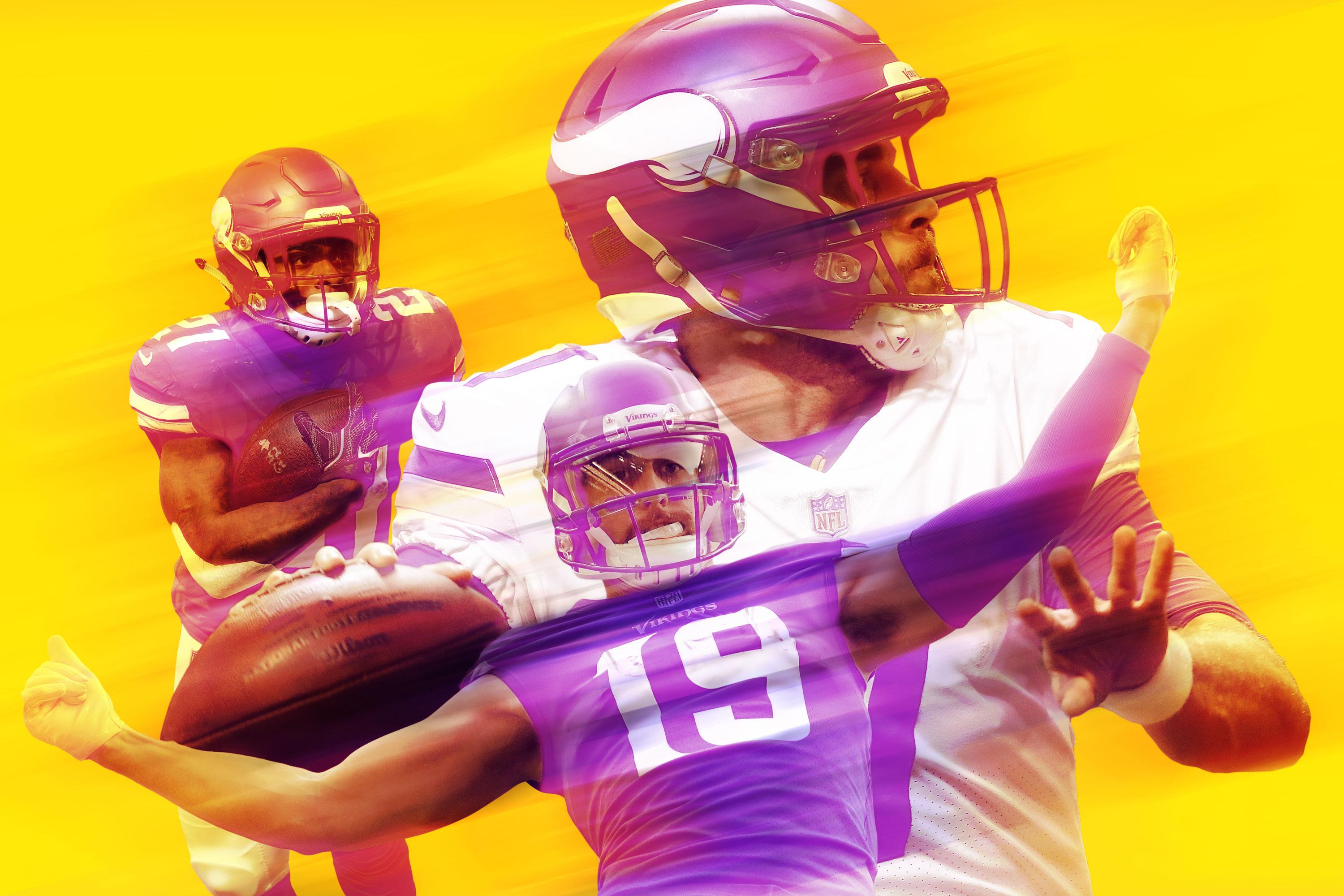Minnesota’s Offense of Misfits Is Built to Overcome
When Sam Bradford and Dalvin Cook went down, the Vikings’ season could have gone sideways. So how has a group led by Case Keenum and Adam Thielen elevated the team to become the NFC favorite?A familiar pall settled over the Vikings early in the third quarter of their Week 4 game against Detroit. Running back Dalvin Cook had crumpled in pain after catching his foot in the U.S. Bank Stadium turf, and the outlook seemed bleak. “It was one of those freak accidents that shook everybody a little bit,” fellow Minnesota running back Jerick McKinnon says now.
The next day, it was revealed that Cook had torn his left ACL. Over the first month of the season, the rookie had been a revelation, rushing for 288 yards through three games before gaining 66 against the Lions. In barely 15 quarters of NFL action, he’d touched the ball 85 times. The 22-year-old was quickly becoming the focal point of Minnesota’s offense. By the first day of October, his season was done.
Cook’s injury came two weeks after quarterback Sam Bradford was a late scratch for the Vikings’ Week 2 game in Pittsburgh due to lingering knee problems. What initially seemed to be a minor issue required arthroscopic surgery, sending Bradford to IR. Within 14 days, a team that had been ravaged by injury in 2016 lost its quarterback and running back for this season. “I was disappointed for Sam, after everything he went through last year, all the hits that he took, and sticking out there,” tight end Kyle Rudolph says. “Then you look and think, ‘OK, where are we gonna go from here?’”
I think having all those injuries last year really helped us realize, ‘It doesn’t matter who’s out there on the field.’ We have enough talent in this locker room to go win games.Vikings tight end Kyle Rudolph
Losing starters at quarterback and running back would be enough to sink most teams’ playoff hopes. Yet instead of cratering, the Vikings offense has emerged as one of the best in the league. Minnesota ranks fifth in Football Outsiders’ offensive DVOA. Backup quarterback Case Keenum — who came to town in April on a one-year, $2 million contract — has completed nearly 68 percent of his throws and tossed 22 touchdowns. Wide receiver Adam Thielen, once a practice-squad player, has racked up 91 catches for 1,276 yards, earning a selection to his first Pro Bowl.
For the Vikings’ homegrown veterans, this season’s success is a product of resilience that’s easy to trace. By now, the team is used to rotten luck. Quarterback Teddy Bridgewater went down with a gruesome knee injury in practice just days before the start of the 2016 campaign. Adrian Peterson missed a combined 28 games in his final three years with the team. Last season, Minnesota finished 30th in adjusted games lost to injury (120.6). Nearly half of those came from the offensive line. No offensive line has had worse injury luck this century.
“I think having all those injuries last year really helped us realize, ‘It doesn’t matter who’s out there on the field,’” Rudolph says. “We have enough talent in this locker room to go win games.”
That talent was bolstered last spring by a flurry of draft and free-agent additions that gave Minnesota one of the deepest rosters in football. Combined with the unexpected emergence of Keenum and others, it’s helped the Vikings withstand the punches to earn a first-round bye and status as the NFC favorite heading into this weekend’s divisional-round matchup with the Saints. “It used to affect us,” sixth-year receiver Jarius Wright says of the roster’s past injury woes. “But I think we have a team now — the guys and the mentality — where I’ve got just as much faith in the next guy as the first guy.”
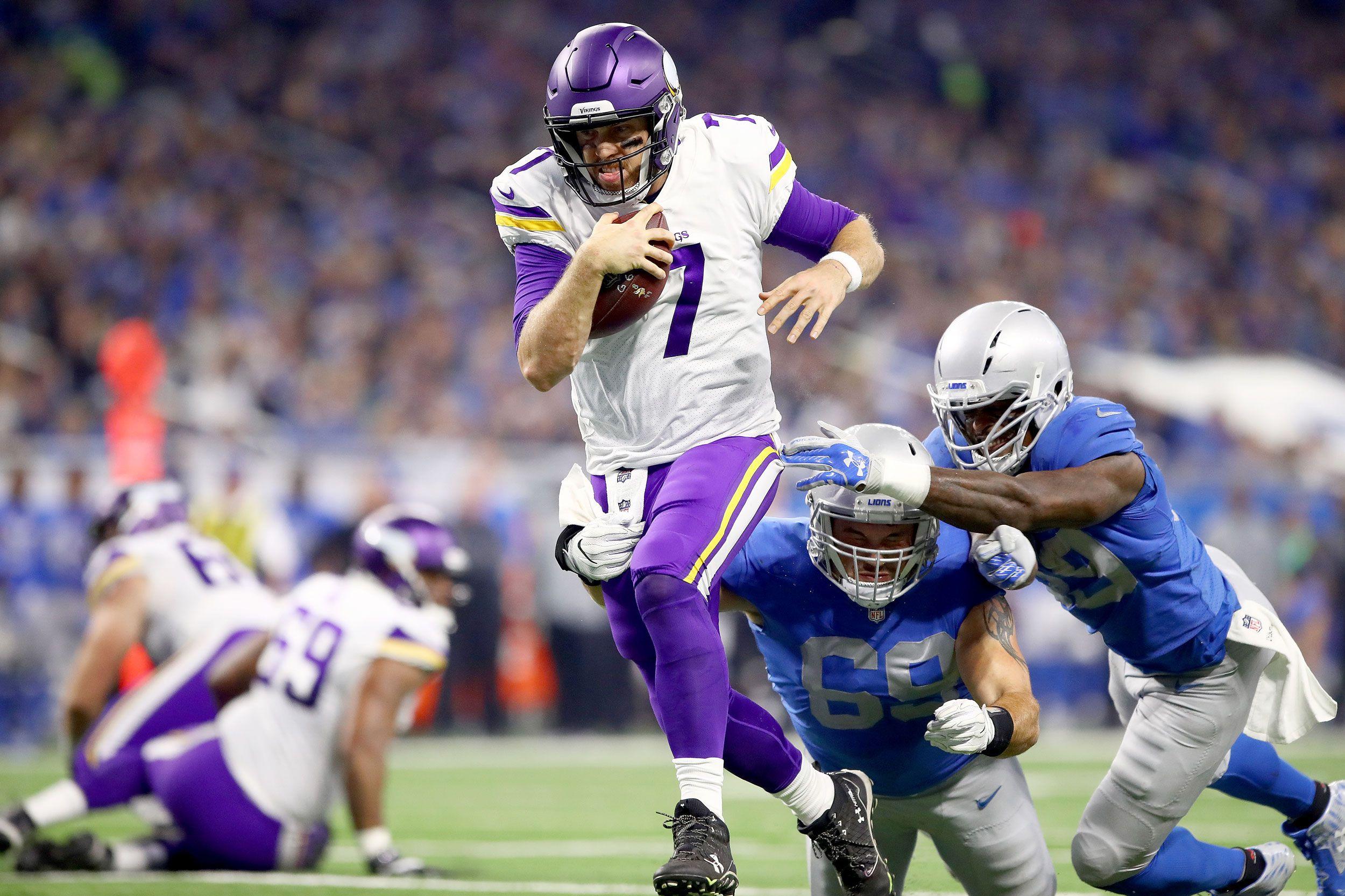
As a second-team wide receiver, Wright worked with Keenum during every practice this offseason. Prior to the two joining forces, the veteran wideout remembers watching Keenum play at the University of Houston, where the Abilene, Texas, native set NCAA records for career passing yards (19,217) and touchdowns (155) from 2007 to 2011. Wright came into this year expecting that Keenum would still be able to sling it, even though the quarterback had turned in a pair of disappointing seasons with the Rams. But the player Wright saw in OTAs was beyond anything he could have imagined. “Even before Case got the opportunity, I was telling one of my buddies, ‘Case is the real deal,’” Wright says. “Not knowing that he would end up having to take over — to show the world he’s the real deal.”
Minnesota entered the 2017 offseason with maybe the strangest quarterback situation in the NFL. Bradford, whom the Vikings had acquired for first- and fourth-round picks in the wake of Bridgewater’s injury, was going into the final year of his contract and was penciled in as the starter. Bridgewater remained on the roster, but his health status for 2017 was unclear. That uncertainty pushed the Vikings’ front office to delve into the murky waters of the free-agent quarterback market in search of a backup.
Keenum had endured a brutal 2016 campaign in more ways than one. When the Rams traded a war chest of draft picks to select Jared Goff first overall the previous spring, Keenum’s days as the Los Angeles starter became numbered. He threw nine touchdowns and 11 interceptions in nine games while keeping Goff’s seat warm, and finally was sent to the bench in mid-November. In seven starts, Goff was even worse, posting historically anemic numbers even by rookie standards.
Even before Case got the opportunity, I was telling one of my buddies, ‘Case is the real deal.’Vikings receiver Jarius Wright
Quarterback success was hard to find in the Rams’ Stone Age offense. In the Vikings’ evaluations, the staff was forced to sift through context and project how Keenum could perform in a more schematically friendly setting. “The tough part with quarterbacks is that the circumstances matter,” Minnesota quarterbacks coach Kevin Stefanski says. “Sometimes, you’re dealing with some injuries up front or an injury to a wide receiver, and it manifests itself into a tough offense. I think you saw the elements of Case’s game that merited a look. He has a ton of redeemable qualities.”
The initial Vikings practices after Keenum took over for Bradford in September were a gradual feeling-out process. Even the subtlest of differences between passers can affect the integrity of an offense, and for Rudolph, adjusting to Keenum’s stature was a challenge. Bradford stands a towering 6-foot-4; spotting him in the pocket was easy, and tracking the ball from his high release point was simple. Keenum is just 6-foot-1 and was initially harder to find in the backfield. “The ball kind of seems to come out between linemen’s heads and shoulders,” Rudolph says. “But that’s something that after a week or two of practice, you kinda get used to it.”
Some of Keenum’s other quirks took getting used to as well, but ultimately transformed the Vikings offense. Bradford’s movement was limited to a small area in the pocket. Keenum, meanwhile, is liable to end up virtually anywhere on a given pass. “The big thing is that you can’t have any timer in your mind,” right guard Joe Berger says of blocking for Keenum. “Any play can get extended.”
Keenum’s ability to operate outside the team’s offensive structure has given the Vikings an improvisational element that was absent with Bradford. It’s also allowed them to avoid negative plays at an astounding rate. Keenum was sacked just 10.7 percent of the time he was pressured, per Pro Football Focus, the second-lowest rate in the league. His 55.7 percent completion rate under duress was the best in all of football. “As coaches, we’re trying to design plays as, ‘Hit your back foot, take a hitch, ball goes here,’” Stefanski says. “Well, that’s not real football. So Case has done a nice job of, ‘What are you going to do when it’s not there?’ That’s a big charge with him.”
Stefanski’s goal with a quarterback who consistently tries to gnaw every bit of meat from the bone is to keep ambition from drifting into recklessness. “You see aggressive and dumb — I don’t want that,” Stefanski says. “And that’s how we talk. We say, ‘Listen, we’re trying to push this ball downfield come hell or high water. But we’re not going to throw into double coverage. We’re going to know when to take that risk.’”
The result of that flirtation has been a passing game that’s equally efficient and thrilling. Minnesota’s receivers have done their part with a barrage of acrobatic, showstopping catches, and Keenum has repaid them with the utmost trust in 50–50 scenarios. “That’s the beauty of quarterback play, is when you have those guys that are going to go make a play for you,” Stefanski says. “I talk to quarterbacks all the time about how it’s important to know themselves and how I need to throw the ball. Well, it’s also important to know your receivers and where they want the ball.”
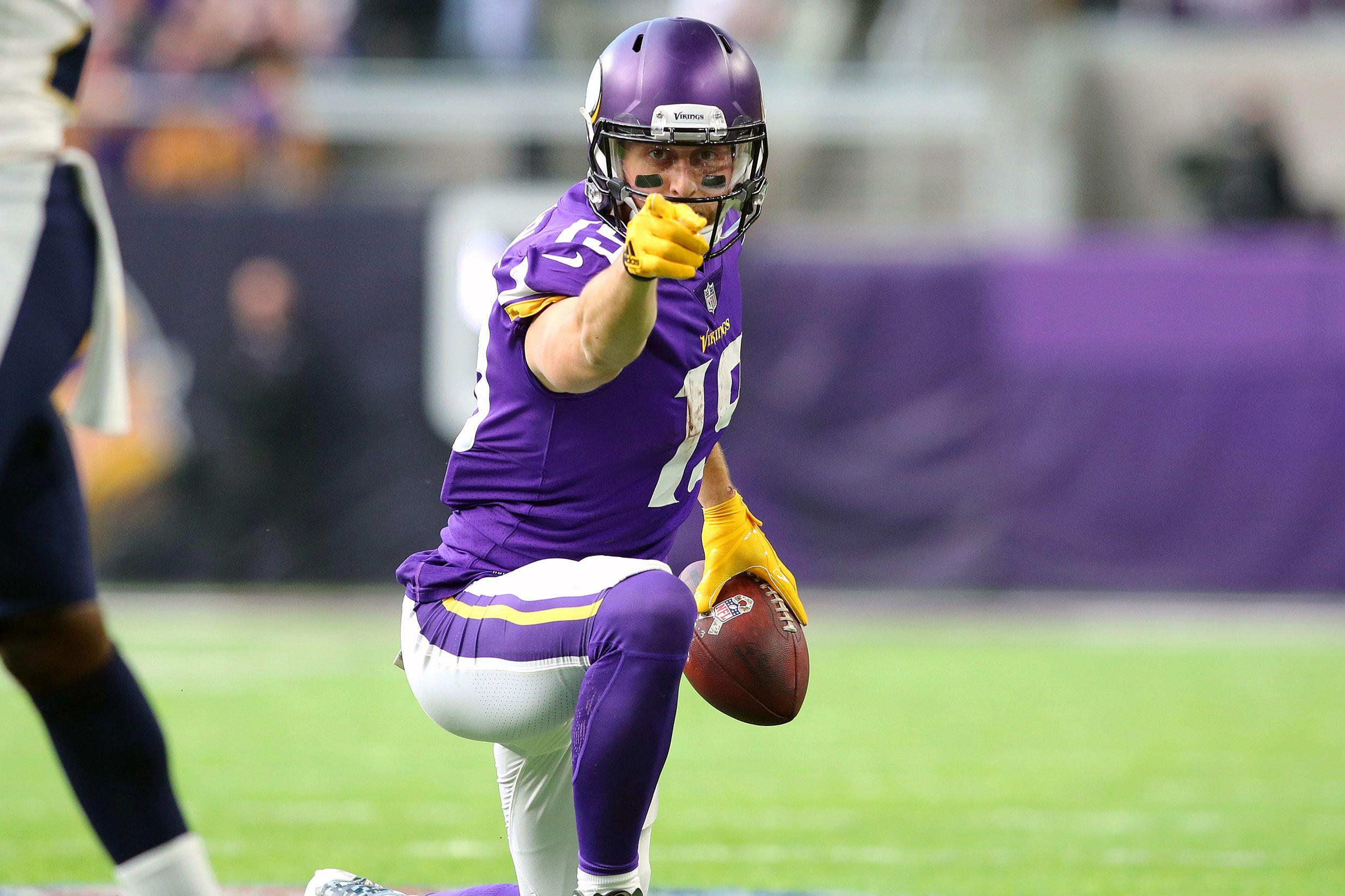
Keenum’s unlikely rise is at the root of how this offense ranks third in passing DVOA, behind only those led by Tom Brady and Philip Rivers. The fuel for that ascension, though, has been a group of pass catchers who can summon plays that simply shouldn’t happen. Rudolph has made his mark primarily as a red-zone threat. Among non–running backs with at least 10 targets inside the opposing 20-yard line, no one had a higher catch rate (87.5 percent). His feel for navigating the constricted area of the field coupled with Keenum’s touch on throws near the goal line has made for an ideal marriage, but to find the element most responsible for the Vikings’ implausible passing success, the scope needs to go even wider.
In my opinion, these last eight to 10 weeks his game has gone off the charts. It’s been fun to watch his maturation in all facets of the game.Vikings receivers coach Darrell Hazell
Last season, the receiving duo of Adam Thielen and Stefon Diggs showed signs of what it could be, and this year those inklings have turned into reality. It’s telling that the star turn of an undrafted free-agent quarterback who was available for next to nothing this offseason isn’t the most surprising story on Minnesota’s offense. In five seasons, Thielen has morphed from training-camp cut to practice-squad player to second-team All-Pro with the fifth-highest receiving total in football. “In my opinion, these last eight to 10 weeks his game has gone off the charts,” Vikings receivers coach Darrell Hazell says. “It’s been fun to watch his maturation in all facets of the game. Whether it’s a release, a catch, a contested catch, a route.”
Thielen is an expert route runner who boasts an uncanny feel for creating separation with the way he subtly sells certain movements. In Minnesota’s 34–17 victory over the Buccaneers in Week 3, the offense hit a series of downfield throws that involved Thielen threatening a defensive back inside before bending his route back toward the corner. Most great route running comes from players possessing short-area quickness and ensuring instant separation; Thielen’s devastating style is no different.
While Thielen isn’t a burner, his ability to manufacture space on longer routes is one of the main reasons that he has the fifth-highest deep ball catch rate in the league among receivers (45.5 percent). Another is that he has a deceptively large frame. Thielen is all of 6-foot-2, and he regularly plays bigger given his knack for pulling in balls that are slightly off target. “He’s a little bit bigger than what you think he is,” Hazell says. “He’s got good length and a nice ability to catch the ball outside of his body with really good range.” When Keenum misses on a pass, it’s often because he tries to lead a receiver too far into space. Luckily, he has a pair of wideouts who know how to flat-out get the ball.
Of the four NFL receivers who were more reliable than Thielen on deep throws, one just so happens to be his teammate. Diggs is shorter than Thielen by 2 inches, and he’s much more liable to break down defenders after the catch. But his ability to attack contested throws in the air can give him the feel of a 6-foot-4 jump-ball artist. Stylistically, Thielen and Diggs are dramatically different. That hasn’t stopped the Vikings from lining them up in similar positions.
Hazell says that one of the keys to Minnesota’s passing game has been the way offensive coordinator Pat Shurmur has taught “conceptual football.” The goal is to make guys understand how the routes fit together rather than penciling each player into a specific role within a concept. By maintaining a built-in level of flexibility, the Vikings are able to deploy Diggs and Thielen interchangeably. Thielen spends most of his time in the slot (where he lined up for 51.1 percent of his snaps), but Diggs still sees plenty of snaps inside. The idea is to make Minnesota’s offense wholly unpredictable. “It’s a lot easier to double guys on the outside,” Hazell says. “If you can get your two best receivers to bounce in, bounce out, it’s hard for [defenses] to come into a game that week and say, ‘All right, we’re going to always double this guy because he’s always outside.’”
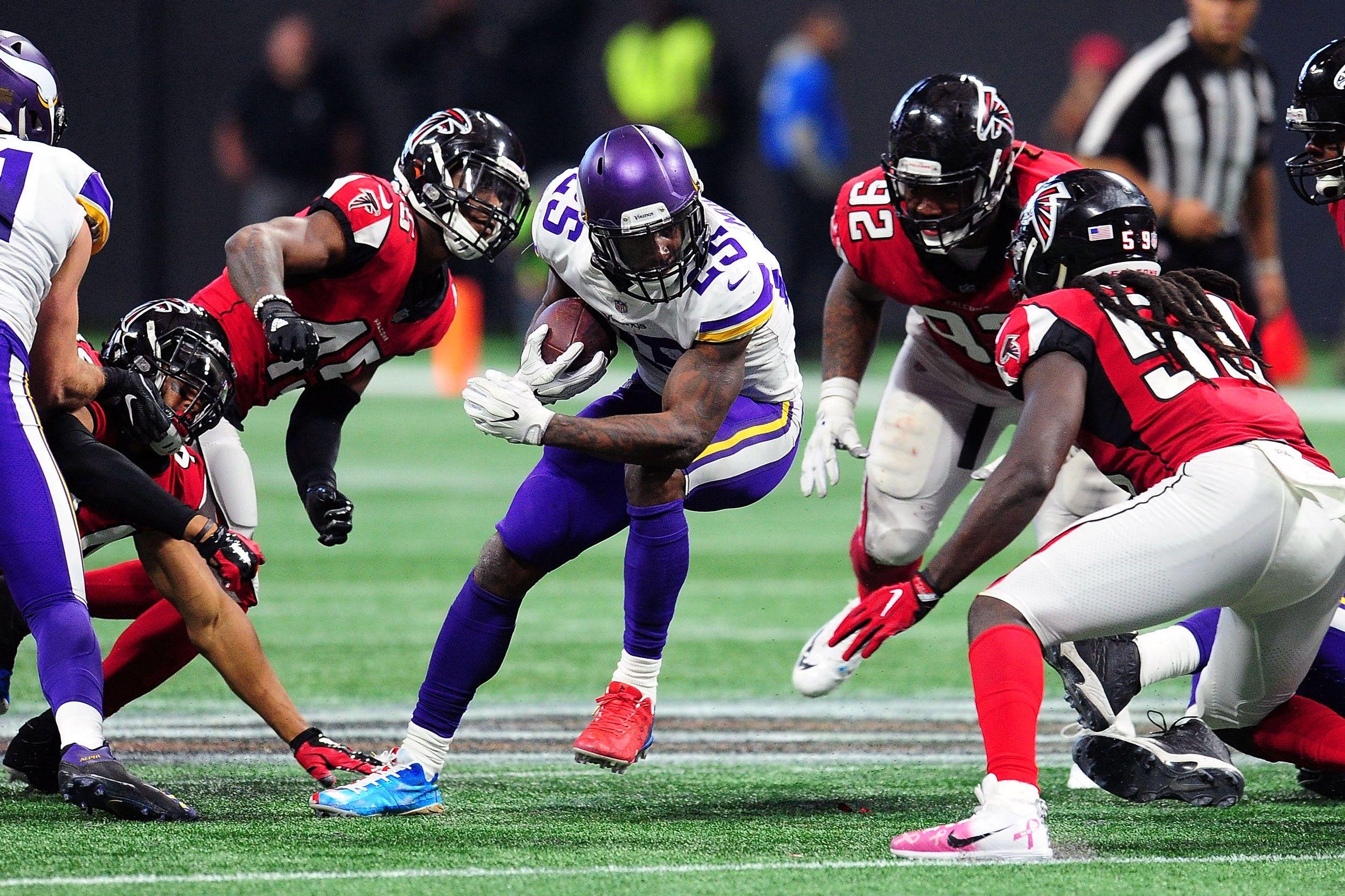
The Minnesota passing game has performed better than even Keenum’s staunchest supporters could’ve anticipated, but it’s also had plenty of help from the Vikings offensive infrastructure. Among quarterbacks who took at least half of their team’s drop backs this season, only Goff (29.1 percent) used play action more often than Keenum (28.7 percent). Keenum’s 111.8 passer rating coming off a play fake ranks fourth in the league, with only three quarterbacks posting higher completion percentages on such plays. “I think the reason we use it so much more this year and why it’s so much more effective is that we actually have a run game,” Rudolph says. “That’s where it all starts from. You go back to the offseason, and goal number one was run the football.”
Minnesota’s ground game was atrocious in 2016. The Vikings averaged a league-worst 3.2 yards per carry and finished 31st in rushing DVOA. No back ran for more than 539 yards. The simplest explanation was Peterson going down with an injury three games into the year, but the future Hall of Famer averaged 1.9 yards per carry before he was lost. The problems were systemic, and many stemmed from a decimated, unsettled offensive line.
The franchise’s outspoken desire to improve the running game over the offseason wasn’t just lip service. General manager Rick Spielman let his resources do the talking. Minnesota spent its first two 2017 draft picks on a running back (Cook, 41st overall) and a center (Pat Elflein, 70th overall). In free agency, Spielman handed running back Latavius Murray a three-year, $15 million contract while also doling out a combined $36.8 million guaranteed to new starting tackles Riley Reiff and Mike Remmers. With plans to shift Berger from center to guard, the Vikings committed to new starters in each of the five spots along the line. The moves represented a complete overhaul of every element in the running game.
That degree of turnover up front can sometimes delay the development of a group largely dependent on cohesion, but Rudolph claims that the line was more settled than in previous years because every starter’s position was set upon his arrival. “Yes, they were all new, but they played together all offseason,” Rudolph says. “You look at last year, I think three out of five spots were position battles all offseason. You didn’t have those guys practicing together in May, June, July, August. Then they’re playing together for a week — all of a sudden, you have a new left tackle.”
Berger can’t put a date on it, but says that he’d played enough snaps between Elflein and Remmers to feel comfortable by the end of training camp. The communication already felt natural. And with Cook running behind them, the rushing attack roared out of the gate. The rookie carried 22 times for 127 yards in a 29–19 win over the Saints in Week 1 — three more rushing yards than the team high for a game in the 2016 season.
With Cook toting the rock, it felt as if the Vikings were poised to have a dominant rushing attack; that notion all but disappeared on that wretched afternoon against Detroit. Given his early-season workload, Cook seemed set to become a feature back rarely seen in the modern NFL. He was on the field for nearly 70 percent of Minnesota’s offensive snaps in his first three games, ceding time to McKinnon only in scattered situations. “When Dalvin was playing, he kind of took the bulk of everything,” McKinnon says. “And we just had our little [roles] in there.”
It’s not about personal success or who’s running the ball. Both of us combined contributing like a single back. I see that as success.Vikings running back Jerick McKinnon
Following Cook’s injury, the rushing responsibilities fell to McKinnon and Murray. While Minnesota’s offensive staff didn’t explicitly tell the tandem how Cook’s workload would be divvied up, the plan crystallized quickly. Murray has far more carries than McKinnon (216 to 150), but McKinnon has taken more than twice as many snaps as Murray as a receiver (295 to 137). Still, rather than split the duties solely by rushing and receiving, the lines between Murray and McKinnon have occasionally blurred. They often line up in identical formations, providing their own spin on the same play designs. “It makes it hard for defenses to hone in on one guy,” McKinnon says. “There are so many different looks, and it’s not like [if] one of us is coming in, and there’s only a handful of plays that could be run.”
The amalgam that’s formed between the two backs is fitting. To McKinnon, the goal was never for either guy to individually replace Cook. His hope was that together they could form a comparable force to the electrifying rookie. “It’s not about personal success or who’s running the ball,” McKinnon says. “Both of us combined contributing like a single back. I see that as success.”
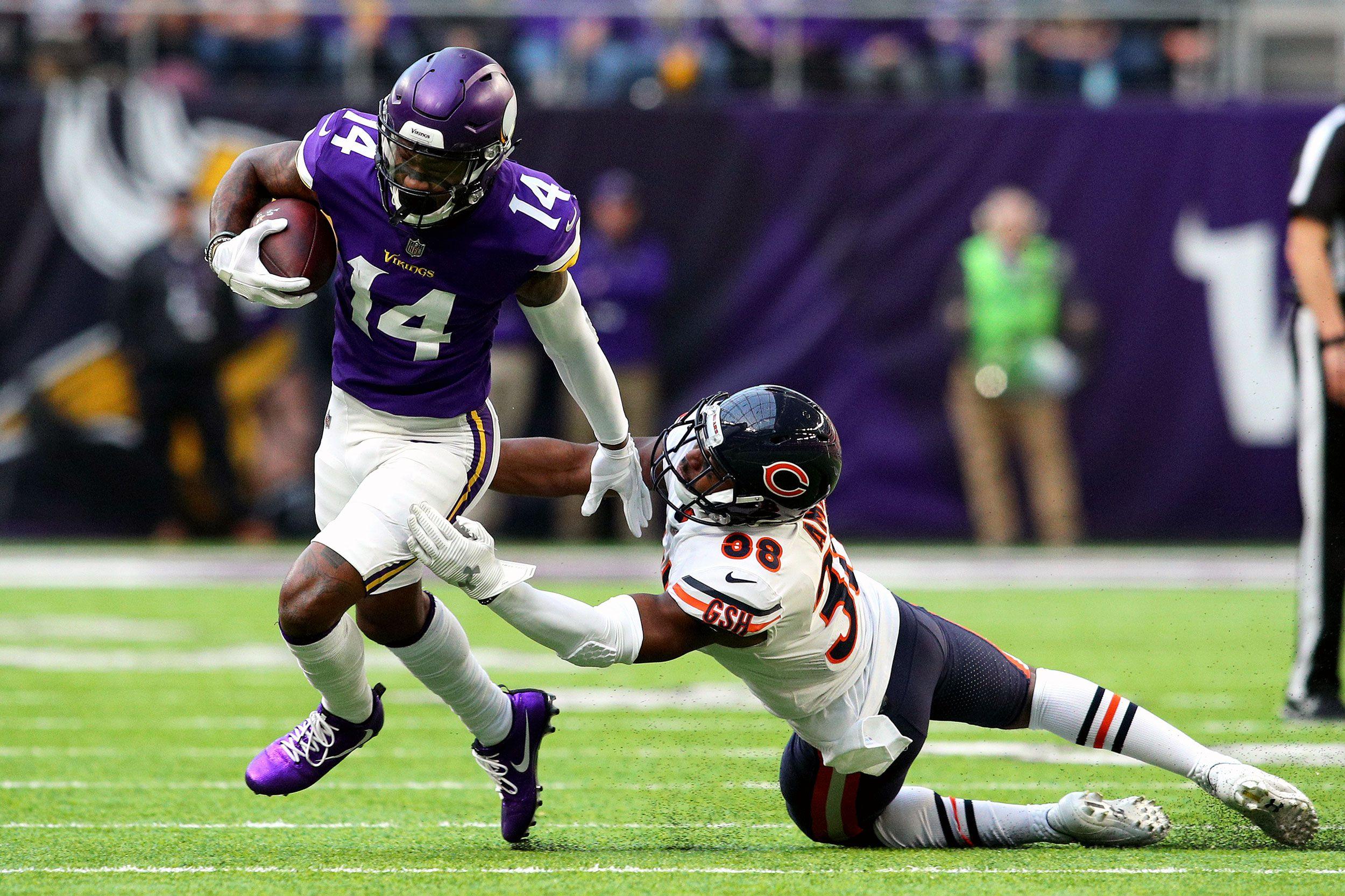
Minnesota’s rushing attack has proved capable this season, but it’s still far from a juggernaut. The Vikings’ no. 18 rushing DVOA ranking and 3.9 yards per carry average are notable mostly because they’re miles ahead of the team’s marks from 2016, and well above the threshold necessary to make a reliance on play-action concepts viable. The combination of McKinnon and Murray has kept Minnesota afloat in Cook’s stead, but the ground game doesn’t provide the same punch that it did early in the 2017 campaign.
And that’s only one of a scroll’s worth of differences between the situation entering the Vikings-Saints playoff matchup and the clash between these teams in Week 1. With Bradford under center in September, Minnesota unleashed an aerial firestorm on a group of young defensive backs whose communication broke down too often. In the months since, New Orleans rookies Marshon Lattimore and Marcus Williams have developed into reliable, high-end pieces. Both Diggs and Thielen can go off against any defense in football, but this secondary is now an entirely different beast.
The Saints’ evolution this season has been that of a young team navigating the treacherous world of the NFL. A collection of absurdly talented young players has meshed and altered the perception of what New Orleans could be at the tail end of the Drew Brees era. An influx of offseason additions provided elements of that process in Minnesota, but the changes in the Vikings offense weren’t about steady growth. They were about survival.
This offense has adapted to withstand one crushing blow after another, and it’s no less formidable without its starting quarterback and running back in the mix. As Keenum and crew eye a Super Bowl berth, there may be no greater compliment that they could receive.
